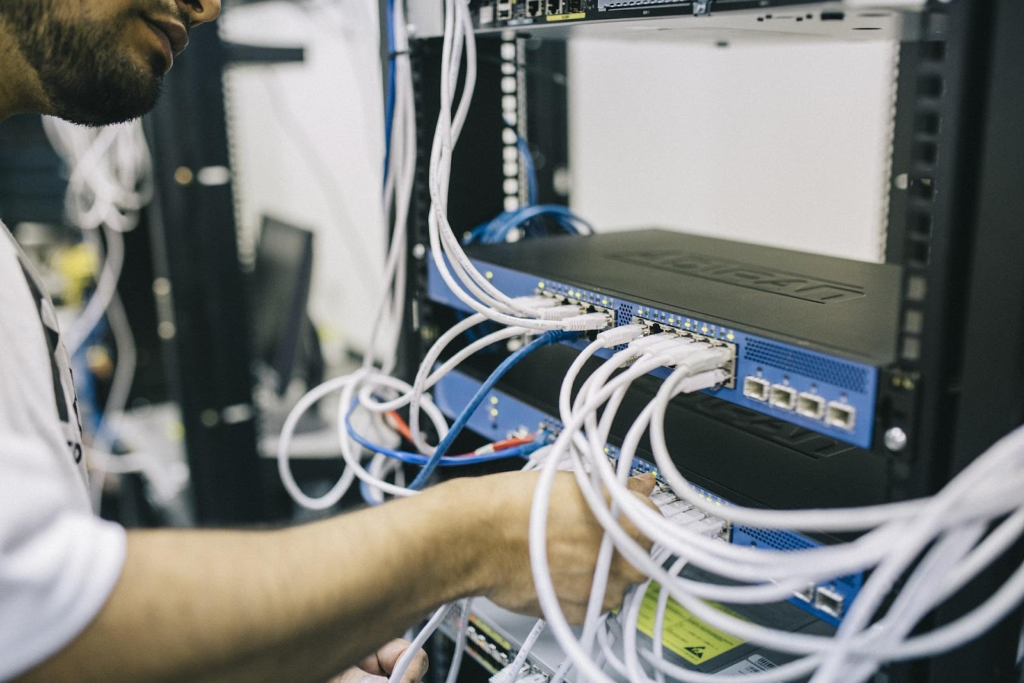If you enjoy streaming Netflix at home or use computers at your business, it’s all thanks to fiber optic cable. Invented in the 1960s, fiber optic cable supports the internet, telephone systems, and cable television.
However, there are times when the fiber optic cable must withstand pressure or a harsh environment. That’s where fiber optic armored cable comes in. Armored fiber cable can provide extra protection to the fiber optic cable without losing flexibility or functionality.
Related: Fiber Optic Infrastructure and Internet Guide
Basics of Fiber Optic Armored Cable
Regular fiber optic cable quickly succumbs to damage from crushing or weathering. This is where armored fiber shines. It boasts more durability and flexibility, allowing for use in tighter spaces or more challenging situations.
Armored fiber optic cable consists of multiple layers to keep it intact. An outer plastic jacket and a light steel tube underneath lend ample protection to the fiber cables at the center.
Fiber optic cable is capable of covering great distances. One of the best examples of armored fiber optics is the undersea cables that cover over 10,000 miles and connect continents to create today’s internet. Subsea armored fiber optic cables now carry 99% of all international network traffic.
Never feel lost again when it comes to the technology of your business. C&C Technology Group offers tech tips to help keep you informed!
Types of Fiber Optic Armored Cable

Armored fiber cable falls into several different classifications. These vary based on the type of metal tube used within the cable, the method of installation based on best practices, and the intended application of the fiber optic cable.
Classifications of Metal Tubing
Two types of metal tubes are used for armored fiber optic cable: corrugated armored cable and interlock armored fiber cable.
Interlocking armored fiber cable consists of aluminum armor. This armor wraps around the cable in a helical orientation. You’ll find interlocking armored fiber cables in both outdoor and indoor applications.
Corrugated armored fiber cable has coated steel tape that folds around the cable in a longitudinal direction. You’ll see this type of armored fiber cable typically in outdoor applications, as it offers superior rodent and mechanical protection.
Classifications of Installation Method
Depending on the installation environment, armored fiber cables are either field-terminated or pre-terminated.
Due to the strong metal armor that encases the fiber optic cables within a tube, the termination of the armored fiber cable isn’t as easy as what you’d find with a standard fiber optic cable.
Most outdoor applications benefit from field-terminated armored fiber cables. With pre-terminated armored fiber cable, most installers turn to it for indoor applications.
Classification of Application Method
There are two installation environments for armored fiber cable: indoor and outside plant (OSP). From there, based on the installation environment, you go with either loose-buffered or tight-buffered armored cable.
While loose-buffered and tight-buffered fit outdoor and indoor applications, you’ll most often see loose-buffered in outdoor environments.
Indoor armored fiber cable can be either loose-buffered or tight-buffered. The inner jacket of the armored fiber will typically have interlocking metal armor that wraps in a spiral shape around the cable.
Outdoor armored fiber cable needs to be able to main operation under harsh circumstances, and most have a loose buffer design. Outdoor fiber cables can have either light or heavy armor. Light armored fiber optic cable has a plastic jacket with the same protective capability as a stainless steel cable, while the heavy armored cable has a wire circle wrapping around it for extra protection.
Having trouble determining what type of fiber optic cable your business needs? Contact C&C Technology Group to get specialized help in providing your business with premium solutions.
Installation Guide for Armored Fiber Optic Cable

Armored fiber optic cable boasts the ability to withstand harsh conditions outdoors while still seeing application use indoors. Though armored fiber cable has many advantages, the bonding and grounding process can be difficult.
Follow the below procedures to help avoid any problems during the installation process:
Bend the Cable
About 10 inches from the end, bend the armored cable and squeeze until the coils of the armor separate. It might not be possible to accomplish this task by hand, so be sure to have pliers or another means of cutting on hand.
Twist the Cable
Next, you’ll want to twist the armored cable at each side of the cut. You do this until the split coils of the armor pop out, away from the wires. If you cannot do this by hand, then use two different pairs of pliers.
Cut Exposed Coil
With side cutters, you should next make a cut into the exposed coil of sheathing. This can sometimes prove to be a bit difficult, so you might have to use the side cutters to grip the coil and work it back and forth to even open and make the cut.
Cut the Wires
To cut a piece of cable to length, pull back the sheathing to uncover the wires and cut through. If you don’t need to trim the piece to length and it’s simply unneeded, cut through the wire and discard the extra length.
Remove Excess
If there are any parts of the sheathing that are sharp, use the side cutters to trim them away. Also, remember to remove and discard any paper wrapping or plastic pieces.
Related: Don’t Hire Uncertified Fiber Installers: Here’s Why
Use the Right Armored Fiber Optic Cable for Your Business
When your business is in need of armored fiber optic cable, do your due diligence to know what type will fit your specific situation. Be sure to understand the pull strength rating and the maximum bend radius and have a plan for the installation from start to finish. If you keep all these factors in mind, you’ll help to ensure that installation goes smoothly.
Armored Fiber Optic Cable is a necessity in certain environments, so don’t overlook its usefulness. Be sure to discuss with your installer whether you need to use an armored fiber optic cable or not for your specific situation.
Related: Cable Jacket Ratings: What Does Your Cable Need?
Last Updated on June 8, 2023 by Josh Mahan




